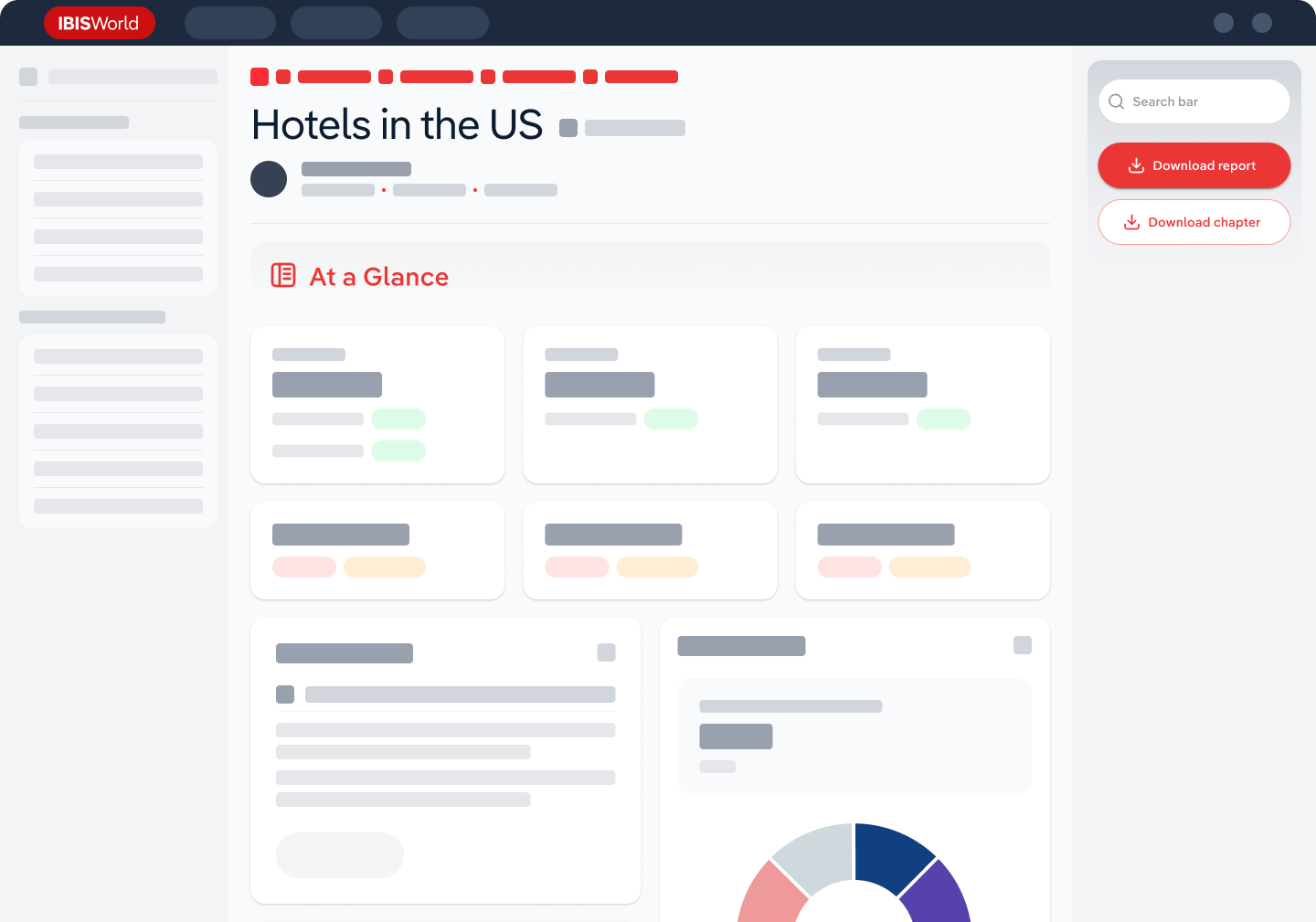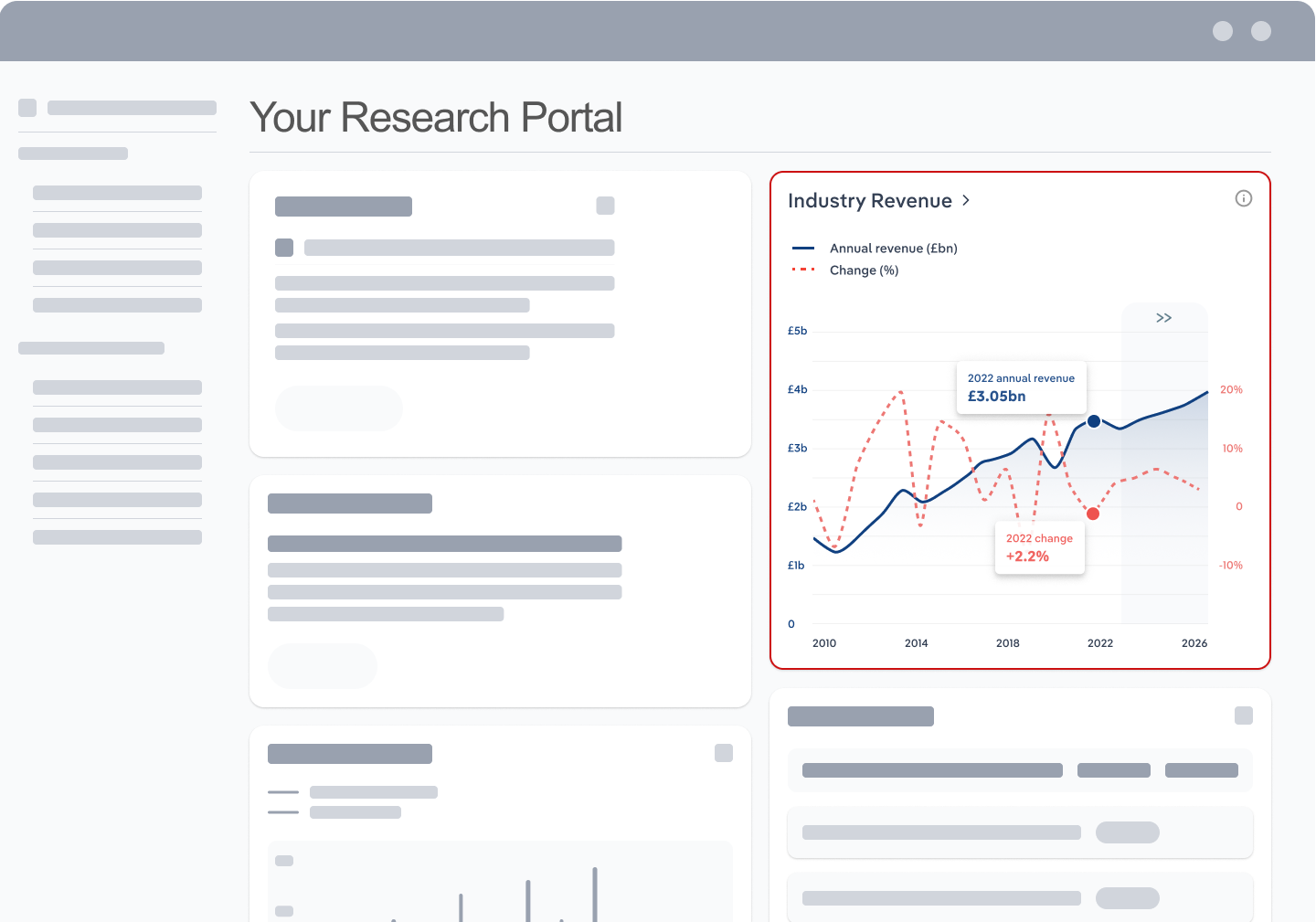Industry Statistics and Trends
Market size and recent performance (2015-2030)
Industry revenue has grown at a CAGR of 0.2 % over the past five years, to reach an estimated $9.8bn in 2025.
Trends and Insights
Historic growth in rental supply lifts the rental vacancy rate
- According to the Canada Mortgage and Housing Corporation's (CMHC) 2024 Rental Market Report (CMHC), the national vacancy rate reached 2.2% in 2024, up from 1.5% in 2023. Canada's supply of purpose-built rental apartments climbed 4.1% in 2024, the highest gain in over 30 years. Despite the historic gain in supply, rental market conditions remain tight in most major markets. The average rent for a 2-bedroom apartment unit rose 5.4% in 2024, highlighting sustained demand for apartment rentals in Canada.
- Additional trends and insights available with purchase
Industry outlook (2025-2030)
Market size is projected to grow over the next five years.
Trends and Insights
Population growth and urbanization will fuel demand
- Canada's population will continue growing and urbanizing, driving demand for rental housing in major cities and surrounding areas. According to Statistics Canada, in 2024, Canada's population climbed by 1.9%, primarily driven by permanent and temporary immigration. While the population growth in 2024 was slower than the record-breaking gain in 2023, it remained historically high.
Biggest companies in the Property Management in Canada
| Company | Market Share (%)
2025 | Revenue ($m)
2025 | Profit ($m)
2025 | Profit Margin (%)
2025 |
|---|---|---|---|---|
FirstService Corporation | 283.3 | 18.5 | 6.5 |
To view the market share and analysis for all 1 top companies in this industry, view purchase options.
Products & Services Segmentation
Industry revenue is measured across several distinct product and services lines, including Residential property management, Nonresidential property management and Other services. Residential property management is the largest segment of the Property Management in Canada.
Trends and Insights
Low vacancy rates fuel demand for residential property management
- A residential property is a type of real estate that is primarily used for residential purposes, providing housing and living accommodations for individuals and families. Residential properties require the most oversight, as managing many full-time residents and the various issues each encounters are complex.
- More insights available in the full report
Table of Contents
About this industry
Industry definition
Industry operators manages residential and nonresidential real estate for others. Property management responsibilities relate to the overall operation of the property, including maintenance, rent collection, trash removal, security and some renovation activities. Operators may also help manage a property’s accounting, but processes relating to the transactions of properties or real estate investments are not included in this industry.
What's included in this industry?
Products and services covered in the Property Management industry in Canada include Residential property management, Nonresidential property management and Other services.Companies
Companies covered in the Property Management industry in Canada include FirstService Corporation.Purchase this report to view all 1 major companies in this industry.
Related Terms
Related terms covered in the Property Management industry in Canada include vacancy rate, tenant and broker.Industry Code
NAICS 531310 - Property Management in Canada
Performance
Get an indication of the industry's health through historical, current and forward-looking trends in the performance indicators that make or break businesses.
Analyst insights
Demand for property management services remains high because of the limited transition from renting to homeownership. Factors such as high mortgage rates and housing prices u...
In this chapter (4)
- Current Performance
- Outlook
- Volatility
- Life Cycle
Key metrics
- Annual Revenue, Recent Growth, Forecast, Revenue Volatility
- Number of Employees, Recent Growth, Forecast, Employees per Business, Revenue per Employee
- Number of Businesses, Recent Growth, Forecast, Employees per Business, Revenue per Business
- Total Profit, Profit Margin, Profit per Business
Charts
- Revenue, including historical (2015-2024) and forecast (2025-2030)
- Employees, including historical (2015-2024) and forecast (2025-2030)
- Businesses, including historical (2015-2024) and forecast (2025-2030)
- Profit, including historical (2015-2025)
- Industry Volatility vs. Revenue Growth
- Industry Life Cycle
Detailed analysis
- Trends in supply, demand and current events that are driving current industry performance
- Expected trends, economic factors and ongoing events that drive the industry's outlook
- Key success factors for businesses to overcome volatility
- How contribution to GDP, industry saturation, innovation, consolidation, and technology and systems influence the industry's life cycle phase.
Products and Markets
Learn about an industry's products and services, markets and trends in international trade.
Analyst insight
Residential owners dominate the property management market, with residential properties primarily comprising tenant residences. Non-residential property owners, owning office...
In this chapter
- Products & Services
- Major Markets
Key metrics
- Largest market segment and value in 2025
- Product innovation level
Charts
- Products & services segmentation in 2025
- Major market segmentation in 2025
Detailed analysis
- Trends impacting the recent performance of the industry's various segments
- Innovations in the industry's product or service offering, specialization or delivery method
- Key factors that successful businesses consider in their offerings
- Buying segments and key trends influencing demand for industry products and services
Geographic Breakdown
Discover where business activity is most concentrated in an industry and the factors driving these trends to find opportunities and conduct regional benchmarking.
Analyst insights
Ontario's large population drives the growth of its property management industry. This region's robust financial services, IT sectors, manufacturing and natural resources inf...
In this chapter (1)
- Business Locations
Charts
- Share of revenue, establishment, wages and employment in each province
- Share of population compared to establishments in each region in 2025
Tables
- Number and share of establishments in each province in 2025
- Number and share of revenue each province accounts for in 2025
- Number and share of wages each province accounts for in 2025
- Number and share of employees in each province in 2025
Detailed analysis
- Geographic spread of the industry across North America, and trends associated with changes in the business landscape
- Key success factors for businesses to use location to their advantage
Competitive Forces
Get data and insights on what's driving competition in an industry and the challenges industry operators and new entrants may face, with analysis built around Porter's Five Forces framework.
Analyst insights
Property managers face fierce competition. Service providers who offer full-scale solutions at a competitive price are often favored, especially during economic downturns whe...
In this chapter (4)
- Concentration
- Barriers to Entry
- Substitutes
- Buyer & Supplier Analysis
Key metrics
- Industry concentration level
- Industry competition level and trend
- Barriers to entry level and trend
- Substitutes level and trend
- Buyer power level and trend
- Supplier power level and trend
Charts
- Market share concentration among the top 4 suppliers from 2020-2025
- Supply chain including upstream supplying industries and downstream buying industries, flow chart
Detailed analysis
- Factors impacting the industry’s level of concentration, such as business distribution, new entrants, or merger and acquisition activity.
- Key success factors for businesses to manage the competitive environment of the industry.
- Challenges that potential industry entrants face such as legal, start-up costs, differentiation, labor/capital intensity and capital expenses.
- Key success factors for potential entrants to overcome barriers to entry.
- Competitive threats from potential substitutes for the industry’s own products and services.
- Key success factors for how successful businesses can compete with substitutes.
- Advantages that buyers have to keep favorable purchasing conditions.
- Advantages that suppliers have to maintain favorable selling conditions.
- Key success factors for how businesses can navigate buyer and supplier power.
Companies
Learn about the performance of the top companies in the industry.
Analyst insights
FirstService Corporation, a property-related services provider established in 1989 in Ontario, employs around 27,000 people. The company strengthened its operations by purcha...
In this chapter
- Market Share Concentration
- Companies
- Company Spotlights
Charts
- Industry market share by company in 2021 through 2025
- Major companies in the industry, including market share, revenue, profit and profit margin in 2025
- Overview of FirstService Corporation's performance by revenue, market share and profit margin from 2019 through 2025
Detailed analysis
- Description and key data for FirstService Corporation, and factors influencing its performance in the industry
External Environment
Understand the demographic, economic and regulatory factors that shape how businesses in an industry perform.
Analyst insights
Vacancy rates impact property manager's success. While some empty rentals are crucial to maintaining property value, excessive vacancies reduce the demand for management serv...
In this chapter
- External Drivers
- Regulation & Policy
- Assistance
Key metrics
- Regulation & policy level and trend
- Assistance level and trend
Charts
- Regulation & Policy historical data and forecast (2015-2030)
- Assistance historical data and forecast (2015-2030)
Detailed analysis
- Demographic and macroeconomic factors influencing the industry, including Regulation & Policy and Assistance
- Major types of regulations, regulatory bodies, industry standards or specific regulations impacting requirements for industry operators
- Key governmental and non-governmental groups or policies that may provide some relief for industry operators.
Financial Benchmarks
View average costs for industry operators and compare financial data against an industry's financial benchmarks over time.
Analyst insights
Profit hinges on the success of rentals. When the rental market is healthy, more is spent on management services, boosting revenue.
In this chapter
- Cost Structure
- Financial Ratios
- Key Ratios
Key metrics
- Profit margin, and how it compares to the sector-wide margin
- Average wages, and how it compares to the sector-wide average wage
- Largest cost component as a percentage of revenue
- Industry average ratios for days' receivables, industry coverage and debt-to-net-worth ratio
Charts
- Average industry operating costs as a share of revenue, including purchases, wages, depreciation, utilities, rent, other costs and profit in 2025
- Average sector operating costs as a share of revenue, including purchases, wages, depreciation, utilities, rent, other costs and profit in 2025
- Investment vs. share of economy
Data tables
- Liquidity Ratios (2018-2023)
- Coverage Ratios (2018-2023)
- Leverage Ratios (2018-2023)
- Operating Ratios (2018-2023)
- Assets (2018-2023)
- Liabilities (2018-2023)
- Cash Flow & Debt Service Ratios (2015-2030)
- Revenue per Employee (2015-2030)
- Revenue per Enterprise (2015-2030)
- Employees per Establishment (2015-2030)
- Employees per Enterprise (2015-2030)
- Average Wage (2015-2030)
- Wages/Revenue (2015-2030)
- Establishments per Enterprise (2015-2030)
- IVA/Revenue (2015-2030)
- Imports/Demand (2015-2030)
- Exports/Revenue (2015-2030)
Detailed analysis
- Trends in the cost component for industry operators and their impact on industry costs and profitability
Key Statistics
Industry Data
Data Tables
Including values and annual change:
- Revenue (2015-2030)
- IVA (2015-2030)
- Establishments (2015-2030)
- Enterprises (2015-2030)
- Employment (2015-2030)
- Exports (2015-2030)
- Imports (2015-2030)
- Wages (2015-2030)
Top Questions Answered
Unlock comprehensive answers and precise data upon purchase. View purchase options.
What is the market size of the Property Management industry in Canada in 2025?
The market size of the Property Management industry in Canada is $9.8bn in 2025.
How many businesses are there in the Property Management industry in Canada in 2025?
There are 35,145 businesses in the Property Management industry in Canada, which has grown at a CAGR of 2.5 % between 2020 and 2025.
How may import tariffs affect the Property Management industry in Canada?
The Property Management industry in Canada is unlikely to be materially impacted by import tariffs with imports accounting for a low share of industry revenue.
How may export tariffs affect the Property Management industry in Canada?
The Property Management industry in Canada is unlikely to be materially impacted by export tariffs with exports accounting for a low share of industry revenue.
Has the Property Management industry in Canada grown or declined over the past 5 years?
The market size of the Property Management industry in Canada has been growing at a CAGR of 0.2 % between 2020 and 2025.
What is the forecast growth of the Property Management industry in Canada over the next 5 years?
Over the next five years, the Property Management industry in Canada is expected to grow.
What are the biggest companies in the Property Management industry in Canada?
The biggest company operating in the Property Management industry in Canada is FirstService Corporation
What does the Property Management industry in Canada include?
Residential property management and Nonresidential property management are part of the Property Management industry in Canada.
Which companies have the highest market share in the Property Management industry in Canada?
The company holding the most market share in the Property Management industry in Canada is FirstService Corporation.
How competitive is the Property Management industry in Canada?
The level of competition is moderate and steady in the Property Management industry in Canada.
Methodology
How are IBISWorld reports created?
IBISWorld has been a leading provider of trusted industry research for over 50 years to the most successful companies worldwide. With offices in Australia, the United States, the United Kingdom, Germany and China, we are proud to have local teams of analysts that conduct research, data analysis and forecasting to produce data-driven industry reports.
Our analysts start with official, verified and publicly available sources of data to build the most accurate picture of each industry. Analysts then leverage their expertise and knowledge of the local markets to synthesize trends into digestible content for IBISWorld readers. Finally, each report is reviewed by one of IBISWorld’s editors, who provide quality assurance to ensure accuracy and readability.
IBISWorld relies on human-verified data and human-written analysis to compile each standard industry report. We do not use generative AI tools to write insights, although members can choose to leverage AI-based tools within the platform to generate additional analysis formats.
What data sources do IBISWorld analysts use?
Each industry report incorporates data and research from government databases, industry-specific sources, industry contacts, and our own proprietary database of statistics and analysis to provide balanced, independent and accurate insights.
Key data sources in Canada include:
- Statistics Canada
- Industry Canada
- Canadian Business Patterns
Analysts also use industry specific sources to complement catch-all sources, although their perspective may focus on a particular organization or representative body, rather than a clear overview of all industry operations. However, when balanced against other perspectives, industry-specific sources provide insights into industry trends.
These sources include:
- Industry and trade associations
- Industry federations or regulators
- Major industry players annual or quarterly filings
Finally, IBISWorld’s global data scientists maintain a proprietary database of macroeconomic and demand drivers, which our analysts use to help inform industry data and trends. They also maintain a database of statistics and analysis on thousands of industries, which has been built over our more than 50-year history and offers comprehensive insights into long-term trends.
How does IBISWorld forecast its data?
IBISWorld’s analysts and data scientists use the sources above to create forecasts for our proprietary datasets and industry statistics. Depending on the dataset, they may use regression analysis, multivariate analysis, time-series analysis or exponential smoothing techniques to project future data for the industry or driver. Additionally, analysts will leverage their local knowledge of industry operating and regulatory conditions to impart their best judgment on the forecast model.
IBISWorld prides itself on being a trusted, independent source of data, with over 50 years of experience building and maintaining rich datasets and forecasting tools. We are proud to be the keystone source of industry information for thousands of companies across the world.
Learn more about our methodology and data sourcing on the Help Center.










